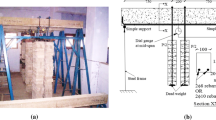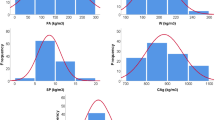Abstract
Machine learning methodologies help to directly determine the desired design parameters of any structural design problem. In this regard, with the present study, a simply supported reinforced concrete (RC) beam with rectangular cross-section was handled for the prediction of the design outcomes as minimum carbon dioxide (CO2) emission and optimal cost level of structural materials. In this respect, firstly, an optimization process was performed with a well-known metaheuristic algorithm, and then a prediction application was realized via artificial neural networks (ANNs) to detect the mentioned parameters. Also, different concrete compression strengths, beam lengths, and concrete cover thicknesses were benefited to generate a dataset for training the ANNs. Finally, to validate the model's success, test data was created and evaluated in comparison with optimal results. Thus, with these processes, both generating of eco-friendly, cost-effective, and optimal designs were made possible to provide, and rapid, effective, and reliable decision-making applications were presented to determine the parameters in terms of the mentioned structural designs.
Access this chapter
Tax calculation will be finalised at checkout
Purchases are for personal use only
Similar content being viewed by others
References
Khalilzade Vahidi E, Rahimi F (2016) Investigation of ultimate shear capacity of RC deep beams with opening using artificial neural networks. Adv Comput Sci Int J 5(4):57–65
Pham AD, Ngo NT, Nguyen TK (2020) Machine learning for predicting long-term deflections in reinforce concrete flexural structures. J Comput Design Eng 7(1):95–106
Bekdaş G, Yucel M, Nigdeli SM (2021) Evaluation of metaheuristic-based methods for optimization of truss structures via various algorithms and Lèvy flight modification. Buildings 11(2):49
Yücel M, Bekdaş G, Nigdeli SM, Kayabekir AE (2021) An artificial intelligence-based prediction model for optimum design variables of reinforced concrete retaining walls. Int J Geomech 21(12):04021244
Yücel M, Namli E (2018) Yapay zekâ modelleri ile betonarme yapılara ait enerji performans sınıflarının tahmini. Uludağ Univ J Faculty Eng 22(3):325–346
Liu T, Tan Z, Xu C, Chen H, Li Z (2020) Study on deep reinforcement learning techniques for building energy consumption forecasting. Energy Build 208:109675
Nabavi SA, Aslani A, Zaidan MA, Zandi M, Mohammadi S, Hossein Motlagh N (2020) Machine learning modeling for energy consumption of residential and commercial sectors. Energies 13(19):5171
Yucel M, Öncü-Davas S, Nigdeli SM, Bekdas G, Sevgen S (2018) Estimating of analysis results for structures with linear base isolation systems using artificial neural network model. Int J Control Syst Robot 3:50–56
Moeindarbari H, Taghikhany T (2018) Novel procedure for reliability-based cost optimization of seismically isolated structures for the protection of critical equipment: a case study using single curved surface sliders. Struct Control Health Monit 25(1):e2054
Yucel M, Bekdaş G, Nigdeli SM, Sevgen S (2019) Estimation of optimum tuned mass damper parameters via machine learning. J Build Eng 26:100847
Yaman MA, Abd Elaty M, Taman M (2017) Predicting the ingredients of self compacting concrete using artificial neural network. Alex Eng J 56(4):523–532
Feng DC, Liu ZT, Wang XD, Chen Y, Chang JQ, Wei DF, Jiang ZM (2020) Machine learning-based compressive strength prediction for concrete: An adaptive boosting approach. Constr Build Mater 230:117000
Ahmad A, Ostrowski KA, Maślak M, Farooq F, Mehmood I, Nafees A (2021) Comparative study of supervised machine learning algorithms for predicting the compressive strength of concrete at high temperature. Materials 14(15):4222
Yang XS (2012) Flower pollination algorithm for global optimization. In: International conference on unconventional computing and natural computation. Springer, Berlin, Heidelberg, pp 240–249
TS500: Turkish Standard Requirements for Design and Construction of Reinforced Concrete Structures. Ankara-Turkey (2020)
Paya-Zaforteza I, Yepes V, Hospitaler A, Gonzalez-Vidosa F (2009) CO2-optimization of reinforced concrete frames by simulated annealing. Eng Struct 31(7):1501–1508
Yepes V, Gonzalez-Vidosa F, Alcala J, Villalba P (2012) CO2-optimization design of reinforced concrete retaining walls based on a VNS-threshold acceptance strategy. J Comput Civ Eng 26(3):378–386
Republic of Turkey Ministry of Environment and Urbanization, Directorate of Higher Technical Board, 2021 Construction and Installation Unit Prices. https://webdosya.csb.gov.tr/db/yfk/icerikler//bf2021-turkce-20210129113217.pdf. Last accessed 31 Oct 2021
MATLAB Mathworks, Matlab 2018a. Neural Net Fitting. https://www.mathworks.com/help/deeplearning/ref/neuralnetfitting-app.html. Last accessed 01 Nov 2021
Author information
Authors and Affiliations
Corresponding author
Editor information
Editors and Affiliations
Rights and permissions
Copyright information
© 2022 The Author(s), under exclusive license to Springer Nature Singapore Pte Ltd.
About this paper
Cite this paper
Yücel, M., Bekdaş, G., Nigdeli, S.M. (2022). Prediction of Minimum CO2 Emission for Rectangular Shape Reinforced Concrete (RC) Beam. In: Kim, J.H., Deep, K., Geem, Z.W., Sadollah, A., Yadav, A. (eds) Proceedings of 7th International Conference on Harmony Search, Soft Computing and Applications. Lecture Notes on Data Engineering and Communications Technologies, vol 140. Springer, Singapore. https://doi.org/10.1007/978-981-19-2948-9_14
Download citation
DOI: https://doi.org/10.1007/978-981-19-2948-9_14
Published:
Publisher Name: Springer, Singapore
Print ISBN: 978-981-19-2947-2
Online ISBN: 978-981-19-2948-9
eBook Packages: Intelligent Technologies and RoboticsIntelligent Technologies and Robotics (R0)




